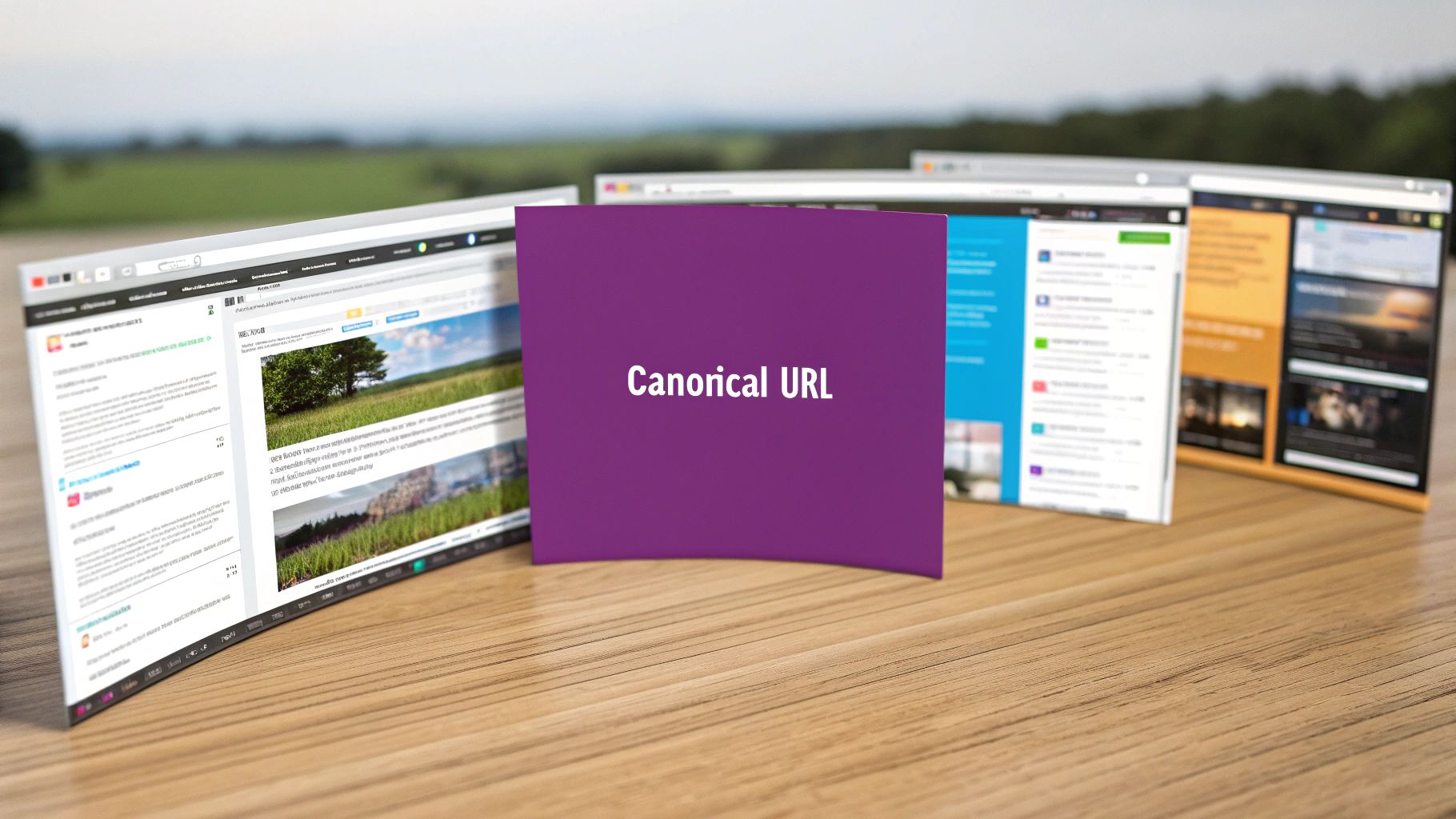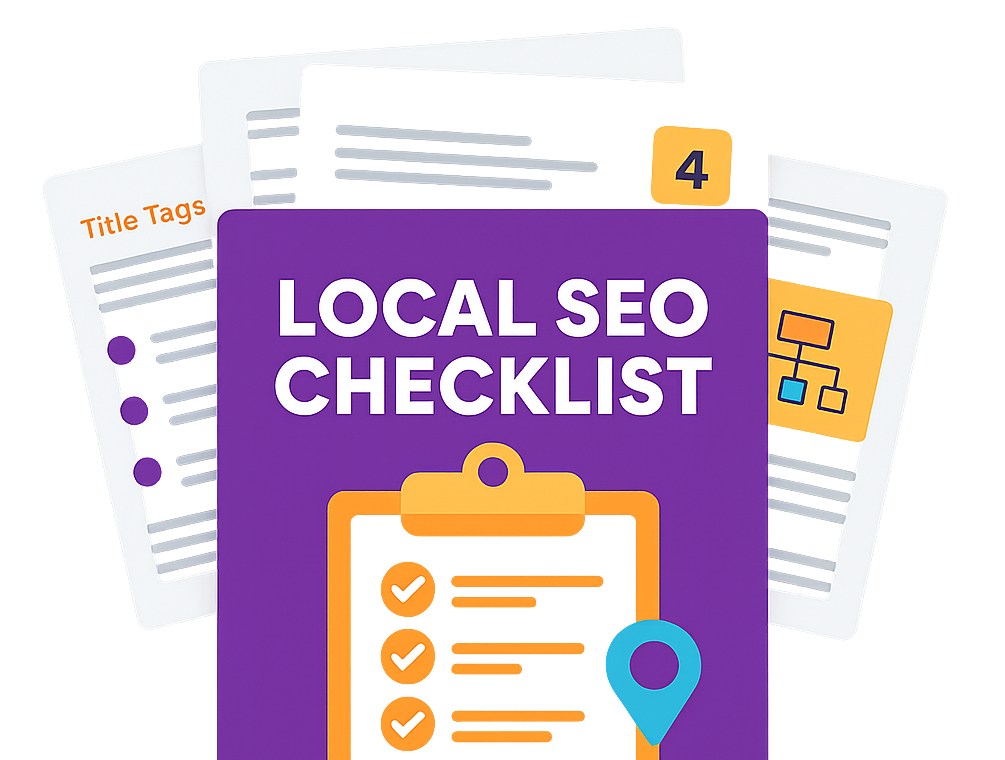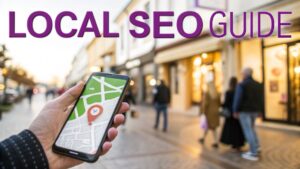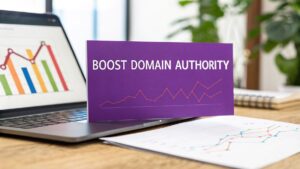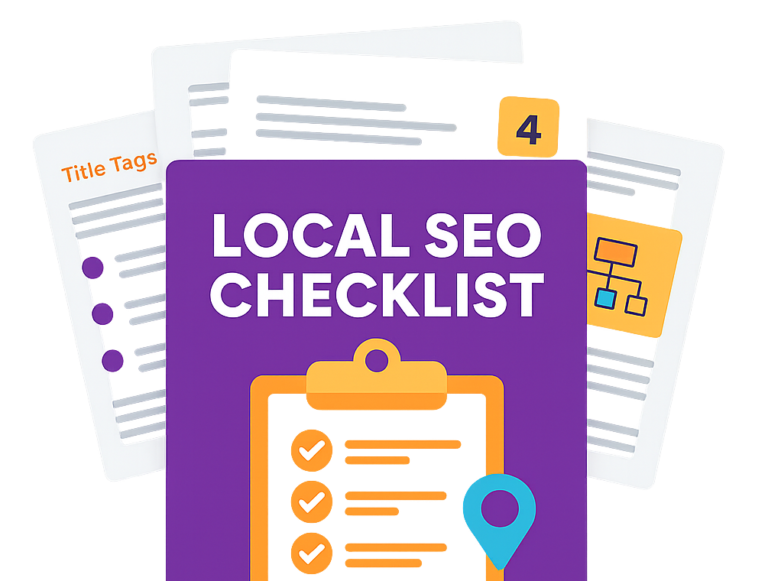Ever had several versions of the same file floating around and needed to mark one as the 'master copy' to avoid chaos? That's pretty much what a canonical URL does for your website. It’s your way of telling search engines which page is the real deal.
What Is a Canonical URL
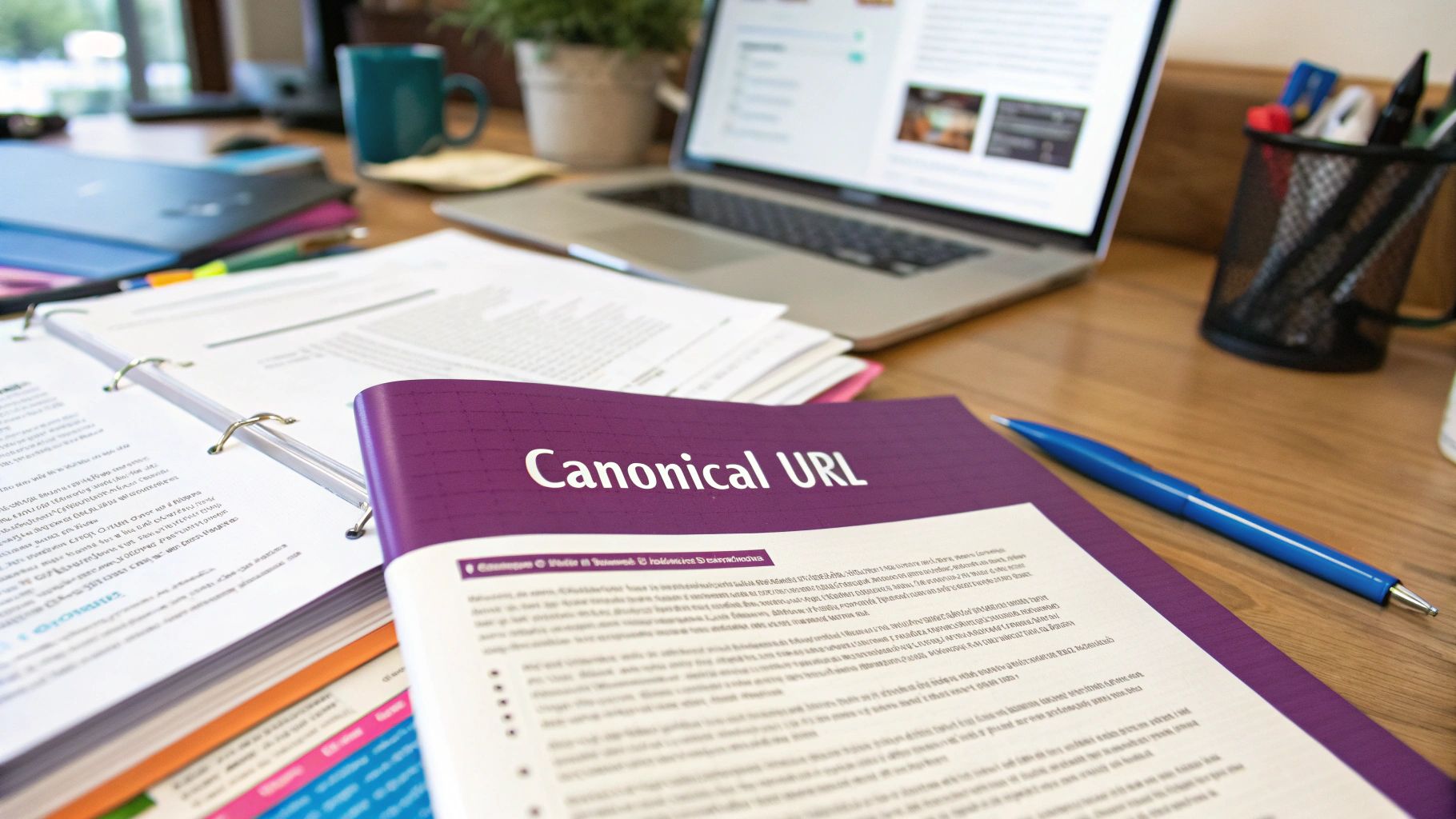
A canonical URL is simply the webpage address you want search engines like Google to see as the definitive version out of a group of duplicate or very similar pages.
You put this into action with a small snippet of code called a canonical tag (you’ll see it written as rel="canonical"). This tag lives in the HTML <head> section of your webpage and points to the master copy. It’s a simple but powerful signal that solves a sneaky problem: duplicate content. Without it, search engines get confused when they find the same material on different URLs.
Why Canonicalisation Is a Cornerstone of SEO
Getting canonicalisation right is fundamental to good website management. Think of it as your site’s librarian, keeping everything organised so search engines can find and index the right content without wasting time.
When you point all the duplicate pages to one master URL, you’re doing a few critical things:
- Consolidating Ranking Signals: All the authority and "link juice" from the duplicate pages get funnelled into your preferred URL. This gives it a much stronger chance to rank.
- Improving Crawl Efficiency: You’re helping Googlebot use its limited crawl budget wisely, focusing on your unique, important pages instead of getting bogged down in copies.
- Preventing Keyword Cannibalisation: It stops your own pages from tripping over each other in the search results, competing for the same keywords.
By telling Google which page to prioritise, you are taking direct control over how your site is understood and valued. This is a crucial step in building a healthy and visible online presence.
Ultimately, canonical URLs are a vital part of any solid SEO strategy. They’re a key pillar of what we call technical SEO—the practice of making your website easy for search engines to crawl and understand.
If you want to go deeper, you can learn more about the fundamentals of what is technical SEO and see how it all fits together to support your digital goals.
The Hidden Dangers of Duplicate Content on Your Website

Duplicate content is one of those sneaky SEO issues that can seriously sabotage your rankings, often without you even knowing it’s happening. This isn't about deliberate plagiarism; it's much more common than that. It happens when the exact same page on your site can be reached via several different URLs.
Think of it like having multiple copies of the same business card, each with a slightly different address. Which one do you want people to use? Search engines face the same dilemma. When they find identical content at different URLs, they get confused about which version is the "official" one to show in search results.
This confusion ends up hurting your site’s performance in a few big ways.
Splitting Your Ranking Power
The biggest problem with duplicate content is that it dilutes your authority. Backlinks are like votes of confidence in the SEO world, telling search engines that your page is credible. But if other sites are linking to all the different versions of your URL, that ranking power—often called ‘link juice’—gets split.
Instead of one URL growing stronger and more authoritative, its potential is spread thin across all the duplicates. None of them end up ranking as well as they could have.
It’s also a massive waste of your crawl budget. Search engines only have a limited amount of time and resources to crawl your site. If they’re spending that time indexing multiple copies of the same page, they have less time to find your new, unique, and important content.
Common Causes of Duplicate Content
You’d be surprised how easily duplicate URLs pop up, especially on UK e-commerce sites. Here are a few of the usual suspects:
- Protocol Variants:
http://vs.https:// - Subdomain Variants:
www.vs.non-www.versions - URL Parameters: Used for tracking or filtering (e.g.,
?source=newsletter) - Trailing Slashes:
example.co.uk/page/vs.example.co.uk/page
These tiny differences create separate URLs for the same content, leading directly to SEO headaches. According to SEO experts at Conductor, this is why using absolute URLs in canonical tags is so important. It clearly points to the master version, and it's a practice that can fix duplicate content issues affecting up to 25% of UK e-commerce crawl budgets.
At the end of the day, leaving these duplicates unmanaged forces Google to guess which page you want to rank. That can lead to the wrong page showing up in search, or even worse, none of them ranking at all. For a deeper dive into getting your URLs right from the start, check out our guide on how to optimise URLs for SEO rankings.
How to Implement Canonical Tags Correctly
Alright, let's get down to the practical side of things. The most common and direct way to point search engines to your preferred URL is by adding a simple rel="canonical" link tag to the <head> section of your webpage's HTML. It's a small bit of code, but it carries a lot of weight.
Think of it as leaving a clear note for Google's crawlers. It essentially says, "Hey, I know you found this page, but please send all the SEO love—the rankings, the authority, the credit—over to this other URL instead." Even when the content is a perfect match, this tag clears up any confusion about which one is the master copy.
So, on a duplicate page you don't want indexed, the code snippet in the <head> section would look something like this:<link rel="canonical" href="https://www.yourwebsite.co.uk/master-page" />
That one line is your workhorse for canonicalisation.
Choosing the Right Implementation Method
While the HTML tag is the standard for most web pages, it's not a one-size-fits-all solution. Depending on the situation, you might need a different approach. You can also specify canonicals through your server's HTTP headers or even within your sitemap.
Not every situation calls for the same tool. Here’s a quick breakdown of the main methods and when to use them.
Methods for Implementing Canonicalisation
| Implementation Method | Best Used For | Example Snippet |
|---|---|---|
HTML rel="canonical" Tag |
The standard for any HTML page. This is your go-to for web pages, blog posts, product pages—you name it. | <link rel="canonical" href="https://example.com/preferred-url" /> |
| HTTP Header | Perfect for non-HTML files like PDFs or Word documents. Since you can't add code to the file, the server does the work. | Link: <https://example.com/preferred-file.pdf>; rel="canonical" |
| Sitemap | A good backup signal, but not a primary method. All pages listed in a sitemap are suggested as canonicals. | <url><loc>https://example.com/page-1</loc>...</url> |
The key is picking the method that makes the most sense for the type of content you're dealing with. For 99% of cases on a standard website, the HTML tag is what you'll be using.
The infographic below gives a nice visual overview of the process.
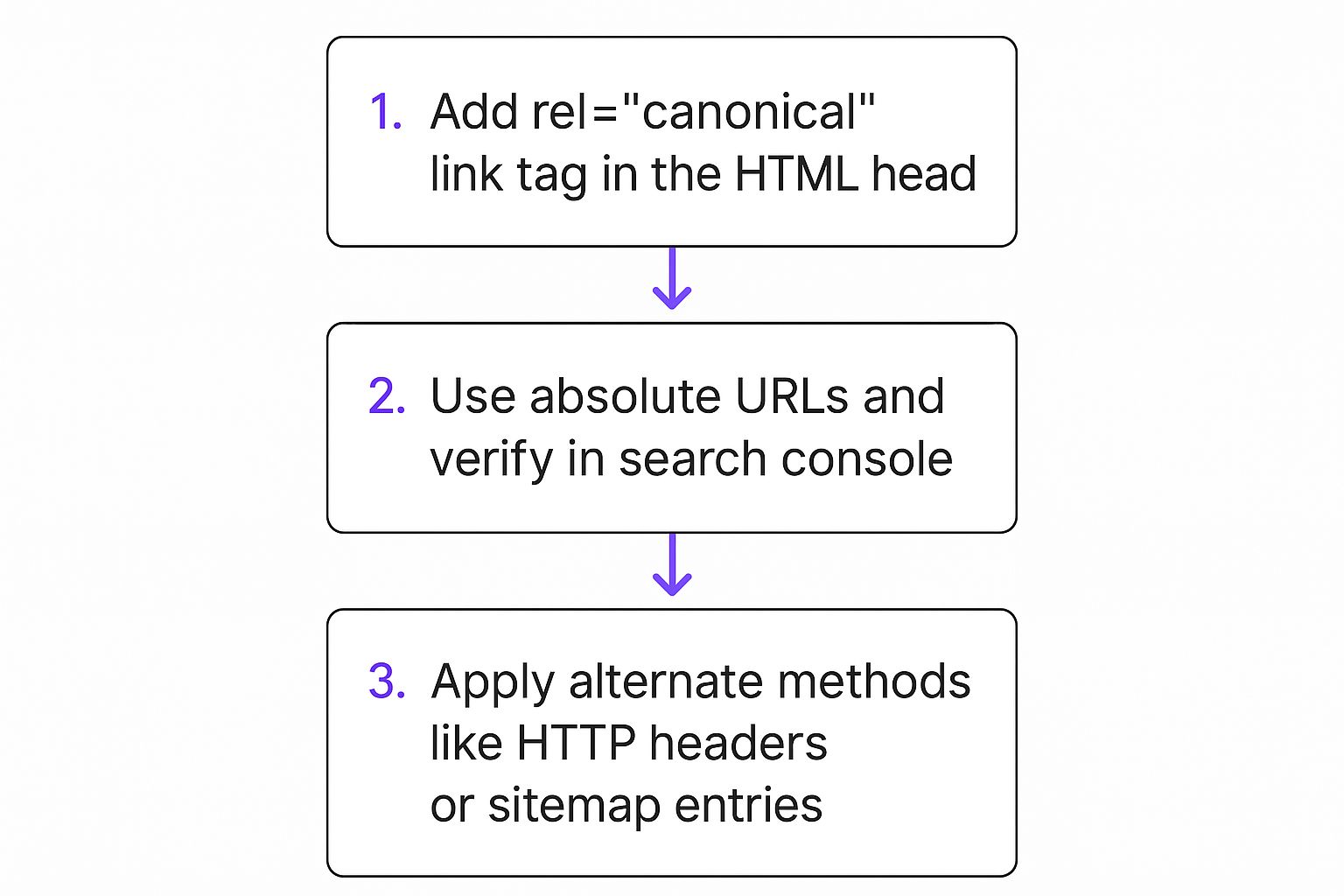
As you can see, simply adding the tag isn't the final step. You have to verify that it’s working and that search engines are actually paying attention to your instructions.
Remember, the goal of implementation is to send a clear, consistent signal. Mixing methods or sending conflicting signals can confuse search engines and undermine your efforts.
Choosing the right implementation ensures your instructions are heard loud and clear. Once you've got them in place, it's absolutely vital to double-check your work—a critical step in our complete technical SEO audit checklist.
Common Canonical Tag Mistakes and How to Avoid Them
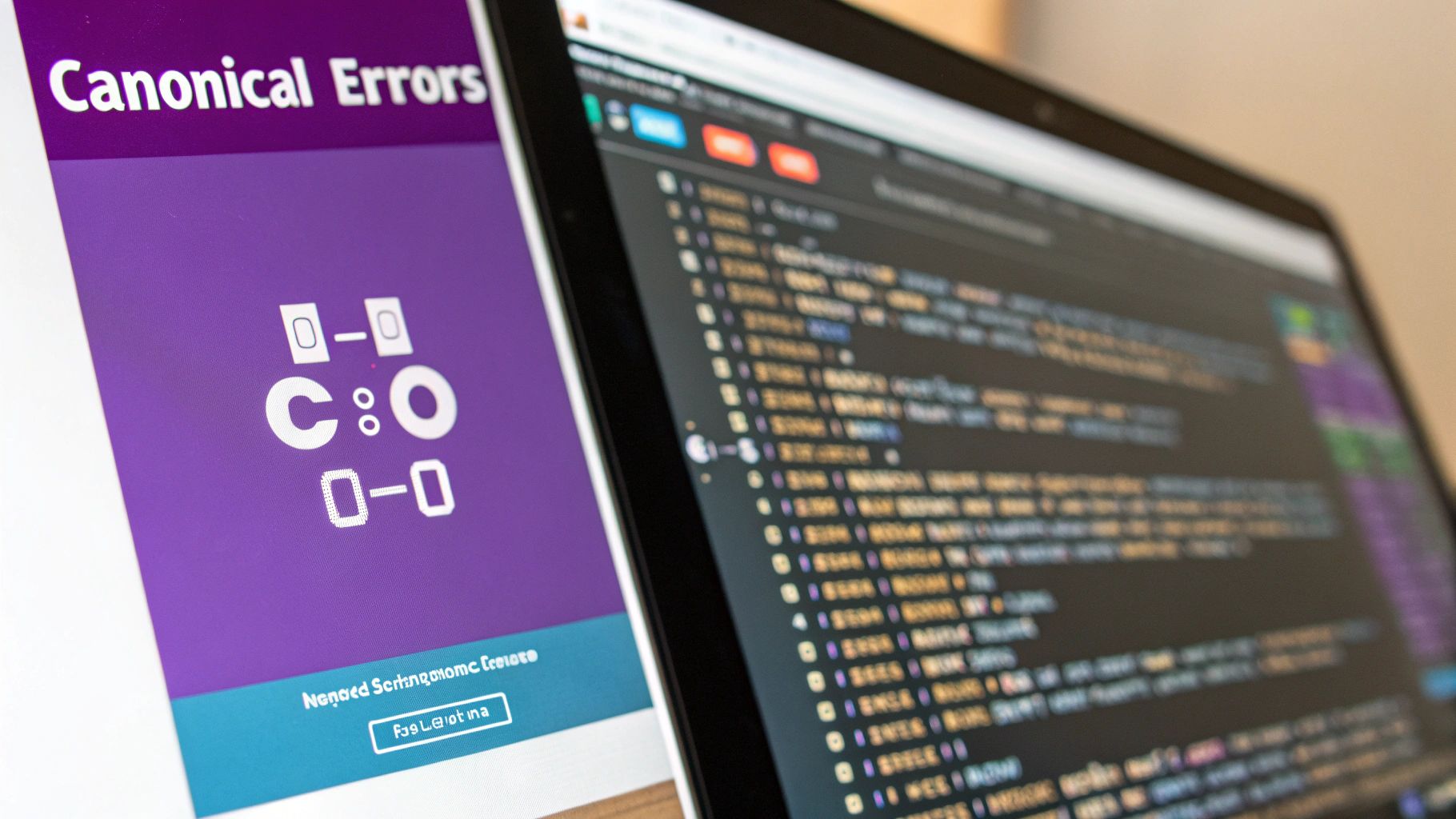
Even with the best intentions, a tiny mistake in your canonical tags can create some serious SEO headaches. Knowing what usually goes wrong is the best way to keep your signals to search engines clean and clear. One of the absolute worst mistakes is pointing a canonical tag to a page that's broken or can't be indexed.
Think about it: you're telling Google that your main page is one that returns a 404 error or has a 'noindex' tag on it. That’s just going to confuse them. The search engine will probably just ignore your instruction and go back to guessing which page it should prioritise.
Using Relative Instead of Absolute URLs
Another classic slip-up is using a relative URL path (like /blog-post) instead of an absolute one (https://www.yourwebsite.co.uk/blog-post). It might seem like a small shortcut, but crawlers can easily misinterpret relative paths. This can lead to them indexing the wrong version of your page, maybe under a different subdomain or protocol (like HTTP instead of HTTPS).
Always, always use the full, absolute URL in your canonical tags. It leaves no room for confusion and guarantees search engines know the exact address of your master page.
Sending Mixed and Conflicting Signals
Websites can sometimes send completely contradictory canonical signals, which is a massive red flag for search engines. This usually happens when a page has more than one rel="canonical" tag in its HTML, or when a tag in the HTML says one thing and another in the HTTP header says something else.
A core principle of effective canonicalisation is to send one clear, consistent instruction per page. Multiple tags create ambiguity, forcing search engines to make their own decision.
SEO reports from UK-based companies often flag this as a major issue. For instance, the team behind the popular tool Screaming Frog stresses that having multiple canonical URLs on a single page can seriously damage your site's search performance, especially for e-commerce sites with loads of product variations.
Mistakes like these can lead to Google simply ignoring your canonical instructions altogether, which is precisely why you need to audit them regularly. When Google ignores your signals, it can lead to frustrating indexing problems. If you're running into those, our guide on how to fix index coverage errors in Search Console is a great place to start.
The Business Impact of Getting Canonicalisation Right
While canonicalisation might sound like something you’d leave to the tech team, its effects ripple right through to your bottom line. Getting it right isn’t just about tidying up your website’s backend; it’s a direct lever you can pull for more visibility and, ultimately, more profit.
Think of it this way: by pointing all your ranking signals to one single, authoritative URL, you're supercharging its ability to perform in search results. A page with stronger authority is far better equipped to climb the rankings and knock competitors out of the top spots for those valuable keywords that bring in customers.
This improved visibility means a healthy boost in qualified organic traffic. And more of the right visitors always translates into more leads, more sales, and a stronger brand in your market.
From Technical Fix to Tangible Growth
The link between a tidy canonical structure and business growth isn't just theory—it’s a proven fact. Ever since Google first introduced the rel="canonical" tag, getting it right has become a cornerstone of good SEO practice for businesses across the UK. Case studies consistently show that fixing canonical issues delivers a significant jump in both search impressions and clicks.
For many small and medium-sized UK businesses, duplicate content is an easy trap to fall into, often created by things like URL parameters for tracking or different versions of a site (like with and without 'www'). Using canonicals to sort this out can be the difference between stagnating and scaling, as it stops your hard-earned marketing efforts from being diluted across multiple weak pages. You can read more about this on Adobe's blog, which dives deeper into the impact.
Proper canonicalisation is not just about avoiding penalties; it's an offensive strategy to concentrate your SEO power, secure higher rankings, and drive meaningful business results.
Investing the time to manage your canonical URLs ensures that every single backlink and every piece of content you create is working as hard as it possibly can to grow your digital footprint and your revenue.
Frequently Asked Questions About Canonical URLs
Even when you've got the basics down, canonicals can throw up some tricky questions when you start putting them into practice. Let's clear up some of the most common queries that pop up.
Should Every Page Have a Canonical Tag?
Yes, absolutely. It's a best practice we follow for every single page on a website. While it might feel a bit pointless for pages that aren't duplicates, think of it as a crucial bit of preventative SEO.
For your original pages, you should use what's called a ‘self-referencing’ canonical tag. This is just a simple rel="canonical" tag that points right back to the page's own URL.
Doing this clears up any confusion for search engines and acts as a powerful defence mechanism. If other sites ever scrape your content and create copies without you knowing, your self-referencing tag makes it crystal clear that your page is the original and deserves all the SEO authority.
What Is the Difference Between a 301 Redirect and a Canonical Tag?
This is a really important one to get right. A 301 redirect is a permanent move that sends both users and search engines from an old URL to a new one. The original URL is completely gone, making it the perfect choice when a page has moved for good.
A canonical tag, on the other hand, is more of a suggestion for search engines. It helps consolidate ranking signals without actually redirecting the user. Both the original and the duplicate pages stay live and accessible, but the tag tells Google which one to treat as the master copy for ranking purposes.
- Use a 301 redirect when a page is gone forever and you want to force everyone to the new location.
- Use a canonical tag when you need multiple versions of a page to exist for users, but you want search engines to focus on just one.
A 301 redirect is a command that forces a move, while a canonical tag is a suggestion that organises content. The right choice boils down to whether you want users to be able to access the duplicate page.
How Can I Check If My Canonical URLs Are Working Correctly?
You don’t have to fly blind here. There are a couple of straightforward ways to check your canonical tags are set up and working as they should be.
The quickest method is to just right-click on your webpage, select 'View Page Source' (or whatever your browser calls it), and do a quick search for rel="canonical". This will show you the exact tag sitting in the HTML.
For a more robust check, head over to the URL Inspection tool in Google Search Console. Pop in a URL, and the report will show you the 'User-declared canonical' (that’s your tag) and the 'Google-selected canonical' (what Google has actually decided to use). If those two line up, you’re golden.
At Bare Digital, we turn complex technical SEO challenges into clear, actionable strategies that drive growth. If you want to ensure your website is perfectly optimised to dominate the search results, get in touch for your free SEO Health Check. Learn more at https://www.bare-digital.com.

